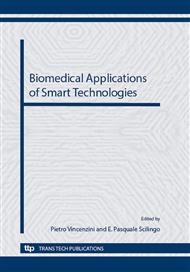[1]
Duceppe N, Tabrizian M. Advances in using chitosan-based nanoparticles for in vitro and in vivo drug and gene delivery. Expert Opin Drug Deliv 2010; 7: 1191-1207.
DOI: 10.1517/17425247.2010.514604
Google Scholar
[2]
Duceppe N, Tabrizian M. Factors influencing the transfection efficiency of ultra low molecular weight chitosan/hyaluronic acid nanoparticles. Biomaterials 2009; 30: 2625-2631.
DOI: 10.1016/j.biomaterials.2009.01.017
Google Scholar
[3]
Douglas KL, Piccirillo CA, Tabrizian M. Effects of alginate inclusion on the vector properties of chitosan-based nanoparticles. J Control Release 2006; 115: 354-361.
DOI: 10.1016/j.jconrel.2006.08.021
Google Scholar
[4]
Douglas KL, Piccirillo CA, Tabrizian M. Cell line-dependent internalization pathways and intracellular trafficking determine transfection efficiency of nanoparticle vectors. Eur J Pharm Biopharm 2008; 68: 676-687.
DOI: 10.1016/j.ejpb.2007.09.002
Google Scholar
[5]
Sanvicens N, Marco MP. Multifunctional nanoparticles - properties and prospects for their use in human medicine. Trends in Biotechnology 2008; 26: 425-433.
DOI: 10.1016/j.tibtech.2008.04.005
Google Scholar
[6]
Kim S, Kim JH, Jeon O, Kwon IC, Park K. Engineered polymers for advanced drug delivery. Eur J Pharm Biopharm 2009; 71: 420-430.
DOI: 10.1016/j.ejpb.2008.09.021
Google Scholar
[7]
Ganta S, Devalapally H, Shahiwala A, Amiji M. A review of stimuli-responsive nanocarriers for drug and gene delivery. J Control Release 2008; 126: 187-204.
DOI: 10.1016/j.jconrel.2007.12.017
Google Scholar
[8]
Roy D, Cambre JN, Sumerlin BS. Future perspectives and recent advances in stimuli-responsive materials. Prog Polym Sci (Oxford) 2010; 35: 278-301.
DOI: 10.1016/j.progpolymsci.2009.10.008
Google Scholar
[9]
Wu C, Chen C, Lai J, Chen J, Mu X, Zheng J et al. Molecule-scale controlled-release system based on light-responsive silica nanoparticles. Chem Commun (Camb ) 2008: 2662-2664.
DOI: 10.1039/b804886j
Google Scholar
[10]
Chandra B, Subramaniam R, Mallik S, Srivastava DK. Formulation of photocleavable liposomes and the mechanism of their content release. Org Biomol Chem 2006; 4: 1730-1740.
DOI: 10.1039/b518359f
Google Scholar
[11]
Blanc A, Bochet CG. Isotope effects in photochemistry. 1. o-nitrobenzyl alcohol derivatives. J Am Chem Soc 2004; 126: 7174-7175.
DOI: 10.1021/ja049686b
Google Scholar
[12]
Drake P, Lin YJ. The attachment, modification and release of gold nanoparticles from a photolabile solid phase synthesis resin, a new methodology for nanoparticle surface modification. Thin Solid Films 2006; 515: 245-253.
DOI: 10.1016/j.tsf.2005.12.077
Google Scholar
[13]
Nagasaki T, Taniguchi A, Tamagaki S. Photoenhancement of transfection efficiency using novel cationic lipids having a photocleavable spacer. Bioconjug Chem 2003; 14: 513-516.
DOI: 10.1021/bc0256603
Google Scholar
[14]
Kim MS, Diamond SL. Controlled release of DNA/polyamine complex by photoirradiation of a solid phase presenting o-nitrobenzyl ether tethered spermine or polyethyleneimine. Bioorg Med Chem Lett 2006; 16: 5572-5575.
DOI: 10.1016/j.bmcl.2006.08.030
Google Scholar
[15]
Handwerger RG, Diamond SL. Biotinylated photocleavable polyethylenimine: capture and triggered release of nucleic acids from solid supports. Bioconjug Chem 2007; 18: 717-723.
DOI: 10.1021/bc060280t
Google Scholar
[16]
Kostiainen MA, Smith DK, Ikkala O. Optically triggered release of DNA from multivalent dendrons by degrading and charge-switching multivalency. Angew Chem Int Ed Engl 2007; 46: 7600-7604.
DOI: 10.1002/anie.200701200
Google Scholar
[17]
Sandros MG, Behrendt M, Maysinger D, Tabrizian M. InGaP@ZnS-enriched chitosan nanoparticles: A versatile fluorescent probe for deep-tissue imaging. Adv Funct Mater 2007; 17: 3724-3730.
DOI: 10.1002/adfm.200700439
Google Scholar
[18]
Sandros MG, Shete V, Benson DE. Selective, reversible, reagentless maltose biosensing with core-shell semiconducting nanoparticles. Analyst 2006; 131: 229-235.
DOI: 10.1039/b511591d
Google Scholar
[19]
Oh E, Hong MY, Lee D, Nam SH, Yoon HC, Kim HS. Inhibition assay of biomolecules based on fluorescence resonance energy transfer (FRET) between quantum dots and gold nanoparticles. J Am Chem Soc 2005; 127: 3270-3271.
DOI: 10.1021/ja0433323
Google Scholar
[20]
Han G, You CC, Kim BJ, Turingan RS, Forbes NS, Martin CT et al. Light-regulated release of DNA and its delivery to nuclei by means of photolabile gold nanoparticles. Angew Chem Int Ed Engl 2006; 45: 3165-3169.
DOI: 10.1002/anie.200600214
Google Scholar
[21]
B.K. Pong, B.L. Trout and J.Y. Lee, Modified ligand-exchange for efficient solubilization of CdSe/ZnS quantum dots in water: A procedure guided by computational studies, Langmuir 24 (10) (2008), pp.5270-5276.
DOI: 10.1021/la703431j
Google Scholar
[22]
Alvarez-Lorenzo C, Concheiro A. Intelligent drug delivery systems: polymeric micelles and hydrogels. Mini Rev Med Chem 2008; 8: 1065-1074.
DOI: 10.2174/138955708785909952
Google Scholar
[23]
Medintz IL, Uyeda HT, Goldman ER, Mattoussi H. Quantum dot bioconjugates for imaging, labelling and sensing. Nat Mater 2005; 4: 435-446.
DOI: 10.1038/nmat1390
Google Scholar


